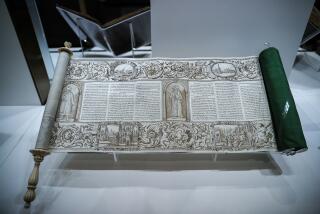A Torah Illuminated With Chutzpah and Poetic Language
According to one of the most cherished tales in rabbinical tradition, a nonbeliever once challenged Hillel, a rabbinical sage of the 1st century BC, to teach him the Torah “while standing on one foot.” The first half of Hillel’s response is famous--”Do not unto others what is hateful unto you”--but the second half is crucial to understanding one of the core values of Judaism and one of the essential uses of the Bible.
“The rest is commentary,” said Hillel. “Now go and study.”
Richard Elliott Friedman, who ranks among the most accomplished and charismatic figures in what is truly a golden age of biblical scholarship, follows in the footsteps of Hillel--and countless other translators and commentators over the last two millenniums--by bringing his impressive expertise to bear on his own English translation of the Torah, as the first five books of the Hebrew Bible are known in Jewish tradition, and a wide-ranging and eye-opening commentary on its origins and meaning.
Friedman, a professor of Hebrew and comparative literature at UC San Diego, is best known for his books on the authorship of the Hebrew Bible, including “Who Wrote the Bible?”--a delightful book that remains the single most accessible introduction to modern Bible scholarship--and, more recently, “The Hidden Book in the Bible,” a startling and even revolutionary study of the literary genius whose work may be buried away in the biblical text.
“Commentary on the Torah” displays not only a scholar’s mastery of biblical Hebrew but also a poet’s ear for language and a healthy measure of sheer chutzpah. After all, as the tale of Hillel illustrates, commentary on the Torah is nothing less than the font of rabbinical Judaism, and it has been practiced by sages and scholars for the last 2,000 years--the very first book printed in Hebrew, Friedman reminds us, was not the Bible but a commentary on the Torah by the revered medieval Talmudist called Rashi.
For anyone who knows Friedman’s earlier work, it is a bit surprising that he does not concern himself with questions of biblical authorship in “Commentary on the Torah.” Rather, he seeks to give us an authoritative but also readable translation of the original Hebrew text, and he expands upon the meaning of the text in a series of marginal annotations that touch on issues of language, history, theology and much else.
Friedman’s approach to the Bible is always respectful but never sanctimonious. For example, he points out that “manna”--the food that is miraculously provided to the Israelites during their wanderings in the wilderness--is actually an elaborate pun on a Hebrew phrase man hu? that actually means “What is it?” At that moment, he invokes not Rashi but Abbott and Costello: “The famous comedy routine of ‘Who’s on first’ in English is actually an equivalent that conveys what is happening here.”
Friedman strives to make his translation clear and compelling to the modern reader, but he refuses to tamper with the text in order to make it more relevant. Thus, for example, he declines to use gender-neutral language in describing God: “The Torah,” he points out, “depicts God as male.” At the same time, he offers a marginal note in which he encourages his readers “to contemplate what this has meant through the ages from the time of the writing of the Torah to their own respective times.”
Similarly, Friedman manages to extract new meanings out of some of the most technical and tedious passages of the Bible. Friedman suggests that the elaborate purification rite for lepers, as described in Leviticus 14, can be understood as a mandate for “bringing people who are infirm back into the community,” and he gives as a contemporary example the use of a balloon to transmit the vibrations of a ram’s horn to deaf congregants during the High Holidays, when the shofar is blown in synagogue.
“As we were once responsible to return and include those who were impure to the congregation,” Friedman writes, “so we may learn to include the handicapped as well.”
Friedman suggests that we need to understand the historical and literary context in which the Bible was composed in order to understand why it is such a revolutionary and enduringly important document. Indeed, that’s a fair description of his life’s work as a Bible scholar. But, here and now, Friedman insists on going back to basics by focusing on the biblical text itself.
“Ultimately, there is no such thing as ‘The Bible as Literature’ or ‘The Bible as History’ or ‘The Bible as . . . anything,’ ” Friedman says. “There is: The Bible.”
More to Read
Sign up for our Book Club newsletter
Get the latest news, events and more from the Los Angeles Times Book Club, and help us get L.A. reading and talking.
You may occasionally receive promotional content from the Los Angeles Times.








